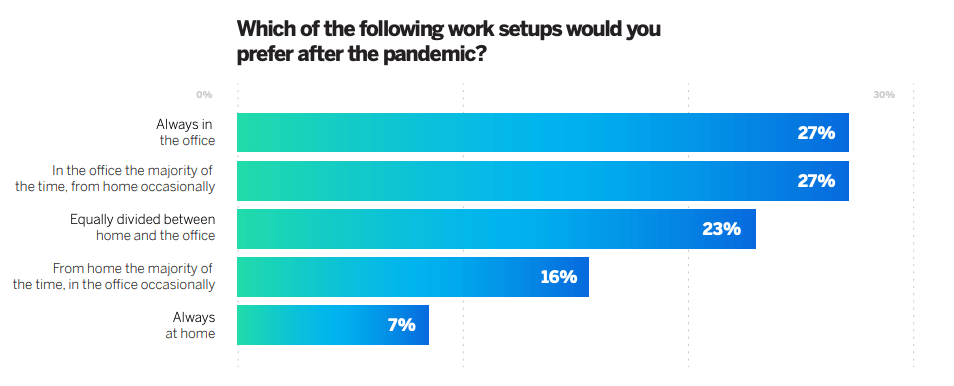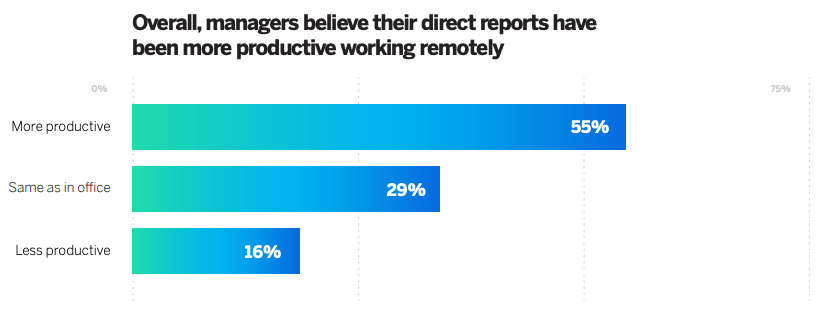After a long period of disruption, we’re attempting to establish a ‘new normal’. Companies are implementing their return-to-work strategies. Employee experience is centre stage.
Our report, ‘The Future of Work in 2021’, explores how the pandemic has changed people’s attitudes, beliefs and expectations.
We spoke to 4,000 people to understand their vision of the ‘new normal’ working world.
A staggering 46% of people expect to see significant changes in their open space when they return to work. Those who work in large, open plan offices are 30% more likely to want change.
We also discovered that 73% want to continue working remotely at least one to two days a week.

Having experienced full-time home-working after a lifetime of office work, people now expect the best of both….
Sally Winston, Head of Employee Experience Solutions Strategy EMEA at Qualtrics, explains how organisations need to respond to new employee expectations of what they want from working life.
With nearly three-quarters of employees wanting to work from home some of the week, we need to design a hybrid mix of physical and remote work in such a way that benefits employees while also creating optimal company performance,” says Sally. “To keep this balance, and improve retention, businesses must keep listening to employees about the reasoning behind their preferences on returning to the office rather than focusing solely on the organisations’ desire to return to ‘normal’ operations.”
Take a look at our Future Work Week infographic
Why working from home works
Businesses and their people have seriously stepped up during the pandemic. They’ve done a remarkable job of making WFH work.
It hasn’t been perfect. Home-schooling, unpleasant or unsafe living environments, inadequate tech and social isolation have been a problem. But despite these challenges only 27% want to go back to the office full-time.
Let’s break down the key factors driving the WFH revolution.
People feel better
Working from home has helped many people cultivate a stronger sense of wellbeing. For every person who says their wellbeing has declined during the pandemic, two say it has improved.
Research from YouGov and otter.ai supports our findings. Avoiding the commute, sleeping in for longer, having a better diet and being able to work more flexibly are reasons people don’t want to rush back to the office.
Evidence also suggests that people take longer lunch breaks when they’re at home. In 2019, the average UK lunch break was 31 minutes. In 2020, that figure increased to 39 minutes.
So, we’re still struggling to take a full hour. But WFH is helping people take more time for themselves during the workday.
Productivity has improved
So you think working from home is for the work shy? Think again…
55% of managers say their direct reports have been more productive during the pandemic. This sentiment is backed up by employees, too. Overall, 51% claim that WFH has had a positive impact on their output.

However, employers should note these gains play out unevenly across age groups. Younger people (Millennials and Gen Z) are more likely than their older colleagues (Gen X and Boomers) to report better productivity from remote working.
The home office boosts productivity for a number of reasons. The people we spoke to credited the improvement to:
- A more flexible schedule (31%)
- No commute (26%)
- More control over workspace (24%)
- Fewer interruptions (24%)
- More privacy and personal space (23%)
These figures tell a compelling story. They reveal a robust rationale behind the increase in productivity. And when it comes to productivity, they show that the home office has qualities that can’t be found at work.
There’s no commute
Not having to commute continually tops the list of reasons why people love working from home. Surprised? We didn’t think so…
We know anecdotally that travelling to and from work is the most unpopular part of the day. It can be uncomfortable, tense and unreliable.
It also takes up a lot of time. In 2019, the average commute time in the UK was an hour a day. For Londoners, this figure jumps to 79 minutes. What’s more, 3.7 million people in the UK spend at least two hours on their daily commute.
Workspace specialist HubbleHq discovered a direct correlation between employees’ commute times and their enjoyment of working from home.
82.4% of people who live within two hours of their workplace said they’d had a positive experience of WFH. This figure drops to 56.4% for those who live 15 minutes away from work.
As such, people who live further away from their workplace want to work remotely more often than those who live closer.
Full report: The future of work in 2021
Free DownloadWhy the office still appeals
The in-person office experience is still attractive. According to our research, 27% of people want to return to their office full-time.
Our respondents told us they miss three things: spontaneous interaction, simply being around others, exposure to a wide range of perspectives and ideas.
Let’s take a more detailed look at why the office is still in favour.
Opportunities for social interaction
Small talk. Water-cooler moments. Chit chat. These fleeting exchanges are an integral part of our work day. And part of what it means to be human.
They help us stay connected. They alleviate boredom. They inspire and make us laugh.
UK job site Totaljobs found that two-thirds of us have felt the loss of social exchange acutely. Women (74%) report being more impacted than men.
Losing contact with work friends was also cited as a cause of loneliness by 36% of those who’ve felt isolated during the pandemic.
Spontaneous interaction simply cannot be replicated at home. For that reason, returning to the office for at least some of the week will be a lifeline for many.
People prefer face-to-face meetings
Just as employees want to reconnect with their colleagues in person, they’re realising there’s a strong case for face-to-face meetings.
‘Zoom fatigue’ is real. Whether it’s eye strain or attempting to look engaged on camera, virtual meetings are mentally and physically draining.
It’s very unnatural to be constantly looking attentive for hours”
– Rafaella Sadun, Professor of Business Administration.
Workspace marketplace Booqed claims that 76% of employees prefer face-to-face over video meetings or phone calls. These people believe it’s easier to make big decisions in person. They also feel facetime helps reduce misunderstandings and miscommunication.
However, there’s a lot of scope for re-thinking the virtual meeting experience. Transcription software specialist Otter.ai points out that meetings haven’t fundamentally changed since they went virtual in 2020.
So, whilst it’s essential to hear employees’ concerns about Zoom and Teams, remember the experience is open to innovation…
Easier to maintain work/life balance
Being in the office five days a week keeps a clear distinction between home and work. Without that separation, the work day creeps into the evenings. The work/life balance begins to tip in the wrong direction.
In January 2021, employees in the UK were logged on for two hours longer than pre-COVID. Similar trends have emerged in the Netherlands, US and Canada too.
A small number of survey respondents told HubbleHQ that they miss the commute for this very reason. For them, the journey to and from their office marks the start and end of the working day.
This sentiment is supported by a study from the University of Cambridge. The researchers argue that the commute enables a literal and metaphorical transition between work and home. It also encourages employees to manage their boundaries more effectively.
As such, going to the office can have a positive effect on wellbeing as much as WFH can.
What employees want from the ‘new normal’
All signs point to a flexible future. Employees want more choice and control over where and when they work. But they’re not ready to abandon the office altogether.
These are the things your people want from their ‘new normal’ world of work.
A hybrid of WFH and office work
The vast majority wants to mix up their working week with at least 1 – 2 days in the workplace. Only 7% would like to WFH permanently. 27% would prefer to work in the office full-time.
Employees want to ‘land’ in the office when needed, not spend five days a week there. They recognise the value of meeting with colleagues and clients in person. And they sometimes need access to physical resources.
Likewise, people recognise the benefits of working from home. They can get on with their work with fewer distractions. They save time on the commute and enjoy being in their own space. But they don’t want the same routine every day.
Our research participants even claim that companies operating a hybrid model will outperform those that don’t…
To live further away from work
The pandemic has ‘lifted the anchor’. It’s proved that people don’t have to live close to where they work.
Employees don’t want to give up this new-found freedom. 80% of people considering a new role want a job which allows them to work remotely at least some of the time.

What’s more, almost half of those who moved away from their work during the pandemic don’t plan to move back.
The right tools
Employees working remotely need reliable access to the right tech and tools. The success of the home/office hybrid depends on it.
Employees expect:
- Communication channels Teams or Slack
- Productivity software and tools
- Monitors and workspace electronics
- A work smartphone
- Project management and task management software and tools
Upgraded office space
A staggering 46% of people expect to see significant changes in their open space when they return to work. Those who work in large, open plan offices are 30% more likely to want change.
Their wish list includes:
- More private and quiet spaces
- More flexible meeting and collaborative spaces
- More space between desks
Open communication
Employees want to know what’s going on. During times of uncertainty, communication is a comfort.
People who work for companies which shared their post-pandemic plans were far more likely to say their wellbeing had improved.
Being transparent about your company’s return-to-work plans is a great way to enhance your employee experience.
Listen, listen, listen
As we start to establish our ‘new normal’ world of work, the most important thing you can do is listen.
Employee needs and expectations have changed dramatically during the pandemic. It’s incumbent on you to design and deliver experiences that work for your people.
Gather feedback at every stage of the employee lifecycle. Listen. And then act on what you’ve heard. Approaching employee experience in this way will differentiate the great companies from the good.
Full report: The future of work in 2021
References
- https://success.qualtrics.com/rs/542-FMF-412/images/Qualtrics-Future-of-Work-2021-Report.pdf
- https://www.totaljobs.com/advice/lockdown-loneliness-the-collapse-of-social-life-at-work
- https://hbswk.hbs.edu/item/you-re-right-you-are-working-longer-and-attending-more-meetings
- https://hubblehq.com/blog/impact-of-commute-time-on-work-preferences
- https://blog.otter.ai/what-employees-think-needs-to-change/
- https://www.repository.cam.ac.uk/handle/1810/302690
- https://www.theguardian.com/business/2021/feb/04/home-workers-putting-in-more-hours-since-covid-research
- https://metro.co.uk/2019/02/08/british-workers-average-lunch-break-lasts-just-31-minutes-8469471/
- https://news.samsung.com/en-gb/the-end-of-the-great-british-lunch-hour-79-of-uk-workers-arent-taking-time-for-themselves-at-lunch
- https://www.totaljobs.com/advice/lockdown-loneliness-the-collapse-of-social-life-at-work
